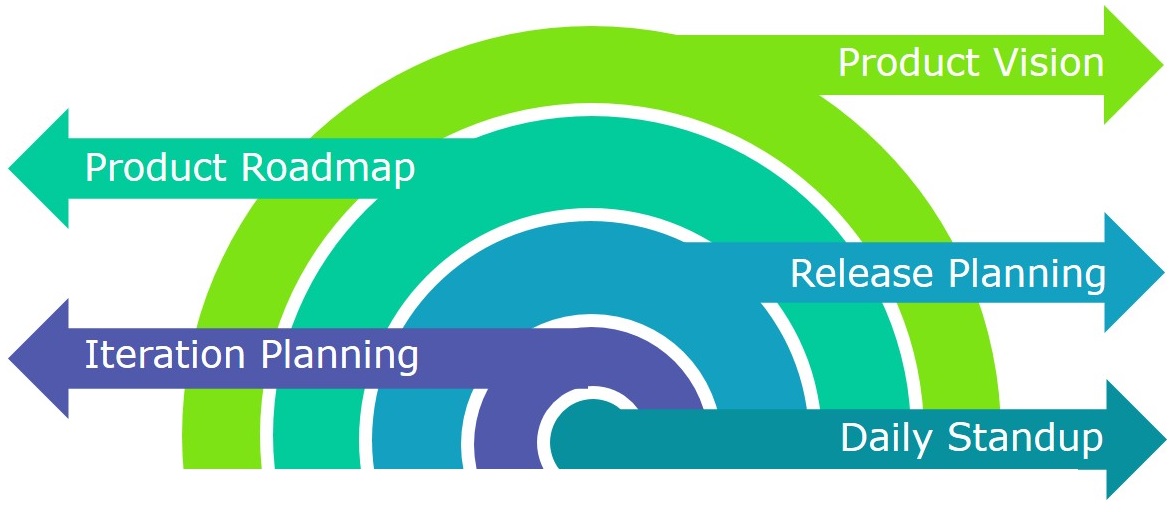5 Levels of Agile Planning

Planning is an inevitable part of everyone's day-to-day activities; whether it relates to weekly shopping for household goods or routine office work. Think about the months of planning that went into organizing a trip to your favorite destination! Each scenario requires some planning, but at different scales.
Let's take this planning and apply it to the field of Agile Software Development. In Agile, there are multiple levels of planning based on the scale and size of the requirements and the defined timeframe.
The requirements, also called Backlogs can come from many stakeholders like the Business, Product Owner or even the Teams. Some of the requirements could be a small enhancement or functional addition to the product that can be completed in an iteration. In case of Backlogs that are bigger in size and cannot fit into one iteration, it can be split into two or more User Stories that are planned into multiple iterations. It is said that your User Story should be small enough to fit into a 'Sticky Note'. Larger backlog items, will be identified as features and these deliver business value to the customers. These features are further broken down into stories that are planned in multiple iterations. At the end of every release, these features, in the form of a working software is delivered and validated. This may or may not really involve multiple Agile teams.
Enterprises usually have many portfolios with many products. There can be large scale requirements, or initiatives like a new product idea itself, which may involve multiple teams and iterations. But how do you handle such large scale initiatives that span across multiple iterations? This requires lot of planning! But hey, in Agile doing upfront planning and design is a big 'No', right?
To counter this, Agile itself suggests 5 levels of planning for such large scale development

1. Product Vision
Product Vision is the long term outcome that the product aims for. All teams align their work to ensure that the ultimate goal and finally, the vision is met. Say, there is an Amusement Park, 'La La Land' with a vision statement: 'To be the 'Go-To' place in entertainment for family and friends in the country in the next three years (20XX)'. This will define the ultimate goal for all 'La La Land' employees.
2. Roadmap
Roadmap is a plan on how the product should evolve to achieve the above vision. The 'La La Land' stakeholders will create a roadmap, which clearly depicts the plan with milestones, defining the steps that will help the enterprise move closer to the goal. A roadmap for the above example could be, by next quarter, finalize cities across the country, where multiple amusement parks could be set up and so on.
3. Release Plan
The Release Plan defines the list of features that will be delivered in the decided timeline. As per the Roadmap, 'La La Land' has plans to launch its branches in top cities of India. As part of its first release, the 'La La Land' team plans to launch rides in Chennai and Mumbai and decides on marketing campaigns and events to be conducted in these cities to popularize the brand.
4. Iteration Plan
During Iteration Planning, teams commit to deliver a set of product backlogs. In order to launch the 'La La Land' branch in Chennai, the Chennai team decides to purchase a Giant Wheel and few Dashing Cars in the next fortnight.
5. Daily Standup
The Daily Standup is where the entire team meets. This usually happens at the start of the day, where each team member shares details on:
- What was done yesterday?
- What are the plans for today?
- Any impediment/issues that are currently being faced. This will be highlighted so that the Scrum Master can help to resolve the issues quickly.
The 'La La Land' Chennai teams meet every day to let the management know about the progress of the launch, which can include procurement details of the Giant Wheel, details of location for installation, electrical setup and so on.
For small products, you may just need the Iteration Planning and Daily Standup.
Therefore, based on the Requirements (Backlogs) size, you may apply few or all the levels of planning as
per the need. As Agile teams, let's continue rolling value to our customers and have happy users and
happy us at the end.
Thanks for subscribing to our latest blogs, thought leadership and other product updates!
Read our Privacy Notice to know more. You can opt-out of all communications anytime.

